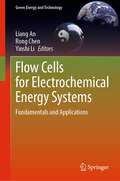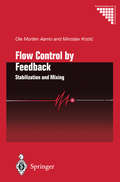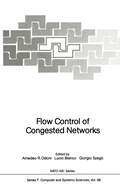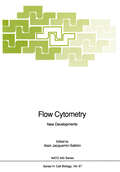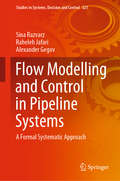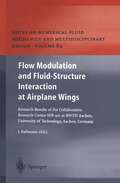- Table View
- List View
Flow Assurance Solids in Oil and Gas Production: Fundamentals Of Solids In Oil And Gas Production
by Jon Steinar GudmundssonThe precipitation and deposition of solids are a major challenge in the production of oil and gas. Flow assurance solids are formed because of unavoidable changes in temperature, pressure and composition of the oil-gas-water flowstream, from reservoir conditions to processing conditions. The advent of subsea production and the increased exploitation of heavy crudes have made flow assurance issues dominant in ensuring efficient and safe exploitation of hydrocarbon assets. Five troublesome flow assurance solids are described in the book: asphaltene, paraffin wax, natural gas hydrate, naphthenate and inorganic scale. These big-five solids are presented in stand-alone chapters. Each chapter is designed to be readable without clutter. Derivations of equations and descriptions of supporting details are given in several appendices. The book is intended for professional engineers and natural scientist working in E&P companies, engineering companies, service companies and specialized companies. An understanding of the big-five solids is required throughout the lifetime of oil and gas assets, from early development to abandonment. The technical, safety and environmental risks associated with deposition problems in near-wellbore formations, production tubing, wellhead equipment, flowlines and processing facilities, are relevant for decisions in the oil and gas industry and in outside regulatory and financial entities.
Flow Batteries: From Fundamentals to Applications
by Christina Roth Jens Noack Maria Skyllas-KazacosFlow Batteries The premier reference on flow battery technology for large-scale, high-performance, and sustainable energy storage From basics to commercial applications, Flow Batteries covers the main aspects and recent developments of (Redox) Flow Batteries, from the electrochemical fundamentals and the materials used to their characterization and technical application. Edited by a team of leading experts, including the “founding mother of vanadium flow battery technology” Maria Skyllas-Kazacos, the full scope of this revolutionary technology is detailed, including chemistries other than vanadium and organic flow batteries. Other key topics covered in Flow Batteries include: Flow battery computational modeling and simulation, including quantum mechanical considerations, cell, stack, and system modeling, techno-economics, and grid behavior A comparison of the standard vanadium flow battery variant with new and emerging flow batteries using different chemistries and how they will change the field Commercially available flow batteries from different manufacturers, their technology, and application ranges The pivotal role of flow batteries in overcoming the global energy crisis Flow Batteries is an invaluable resource for researchers and engineers in academia and industry who want to understand and work with this exciting new technology and explore the full range of its current and future applications.
Flow Batteries: From Fundamentals to Applications
by Christina Roth Jens Noack Maria Skyllas-KazacosFlow Batteries The premier reference on flow battery technology for large-scale, high-performance, and sustainable energy storage From basics to commercial applications, Flow Batteries covers the main aspects and recent developments of (Redox) Flow Batteries, from the electrochemical fundamentals and the materials used to their characterization and technical application. Edited by a team of leading experts, including the “founding mother of vanadium flow battery technology” Maria Skyllas-Kazacos, the full scope of this revolutionary technology is detailed, including chemistries other than vanadium and organic flow batteries. Other key topics covered in Flow Batteries include: Flow battery computational modeling and simulation, including quantum mechanical considerations, cell, stack, and system modeling, techno-economics, and grid behavior A comparison of the standard vanadium flow battery variant with new and emerging flow batteries using different chemistries and how they will change the field Commercially available flow batteries from different manufacturers, their technology, and application ranges The pivotal role of flow batteries in overcoming the global energy crisis Flow Batteries is an invaluable resource for researchers and engineers in academia and industry who want to understand and work with this exciting new technology and explore the full range of its current and future applications.
Flow boiling and condensation in microscale channels (Mechanical Engineering Series)
by Fabio Toshio Kanizawa Gherhardt RibatskiThis book covers aspects of multiphase flow and heat transfer during phase change processes, focusing on boiling and condensation in microscale channels. The authors present up-to-date predictive methods for flow pattern, void fraction, pressure drop, heat transfer coefficient and critical heat flux, pointing out the range of operational conditions that each method is valid. The first four chapters are dedicated on the motivation to study multiphase flow and heat transfer during phase change process, and the three last chapters are focused on the analysis of heat transfer process during boiling and condensation. During the description of the models and predictive methods, the trends are discussed and compared with experimental findings.
Flow Boiling in Expanding Microchannels (SpringerBriefs in Applied Sciences and Technology)
by Tamanna Alam Poh-Seng LeeThis Brief presents an up to date summary of details of the flow boiling heat transfer, pressure drop and instability characteristics; two phase flow patterns of expanding microchannels. Results obtained from the different expanding microscale geometries are presented for comparison and addition to that, comparison with literatures is also performed. Finally, parametric studies are performed and presented in the brief. The findings from this study could help in understanding the complex microscale flow boiling behavior and aid in the design and implementation of reliable compact heat sinks for practical applications.
Flow Boiling in Microgap Channels: Experiment, Visualization and Analysis (SpringerBriefs in Applied Sciences and Technology #10)
by Tamanna Alam Poh Seng Lee Liwen JinFlow Boiling in Microgap Channels: Experiment, Visualization and Analysis presents an up-to-date summary of the details of the confined to unconfined flow boiling transition criteria, flow boiling heat transfer and pressure drop characteristics, instability characteristics, two phase flow pattern and flow regime map and the parametric study of microgap dimension. Advantages of flow boiling in microgaps over microchannels are also highlighted. The objective of this Brief is to obtain a better fundamental understanding of the flow boiling processes, compare the performance between microgap and conventional microchannel heat sinks, and evaluate the microgap heat sink for instabilities and hotspot mitigation.
Flow Boiling of a Dilute Emulsion In Smooth and Rough Microgaps (Mechanical Engineering Series)
by Brandon M. Shadakofsky Francis A KulackiThis book elucidates heat transfer behavior for boiling of dilute emulsions- mixtures of two immiscible fluids- which has received little attention to date. Of the work completed in this area, the majority has been focused on pool boiling where no mean flow is present, and this book is the first major work to be published regarding flow boiling of emulsions. The book includes a comprehensive review and assessment of research on emulsion-based heat transfer. Recent experiments are reported and analyzed to characterize heat transfer in microgap flow boiling via a systematic investigation into the effects of gap size, mass flux, and volume fraction on the heat transfer coefficient and pressure drop. The emulsion used in all experiments comprises droplets of an immiscible electronics cooling fluid suspended in water. The volume provides a complete baseline for flow boiling of water in the microgaps, enabling a determination of the enhancement of the heat transfer coefficient when the disperse component is present. Moreover, a subset of the data set pertains to flow boiling of dilute emulsions over microporous surfaces. The flow conditions for which the microporous surfaces enhance or degrade heat transfer are presented. Finally, this book provides a discussion of the physical phenomena which affect boiling and a set of nondimensional numbers that can be used for correlation.
Flow Cells for Electrochemical Energy Systems: Fundamentals and Applications (Green Energy and Technology)
by Liang An Rong Chen Yinshi LiThis book is a state-of-the-art review on recent advances in flow cells for electrochemical energy systems. The book includes an introduction to flow cells, proton exchange membrane fuel cells, photocatalytic fuel cells, organic flow batteries, redox flow batteries, microfluidic flow cells, as well as electrolysis cells for CO2 and nitrogen reduction. The book provides an essential reference for professors, researchers, and policymakers globally in academia, industry, and government.
Flow Control: Fundamentals and Practices (Lecture Notes in Physics Monographs #53)
by Mohamed Gad-El-Hak Andrew Pollard Jean-Paul BonnetNo be certain it can is not based mathematics. knowledge if upon da Vinci, (Leonardo 1452 1519) the humankind. Thinking is one greatest of Joys of Galilei, (Galileo 1564 1642) Now I think is to be the root all hydrodynamics and is at of physical science, second the to none in its mathematics. present beauty of Thomson (William (Lord Kelvin), 1824 1907) The book contains the lecture notes of of the nine instructors at present eight the short Flow Control: Fundamentals and which held course was Practices, in the week 24 28 June and Carg6se, Corsica, France, during 1996, repeated at the of Notre 9 13 1996. University Dame, Indiana, September Following the week in the course a on same was held. Corsica, 5 day workshop topic Selected from the scheduled to 1998 workshop are papers appear early special volume of the International Journal Heat Thermo of Experimental Transfer, and Fluid All Mechanics. three events were Jean Paul dynamics, organized by Bonnet of Universit6 de Andrew Pollard of Univer Poitiers, France, Queen's at and Mohamed Gad el Hak of the of sity Kingston, Canada, University Notre U.S.A.
Flow Control by Feedback: Stabilization and Mixing (Communications and Control Engineering)
by Ole Morten Aamo Miroslav KrsticThis accessible book pioneers feedback concepts for control mixing. It reviews research results appearing over the last decade, and contains control designs for stabilization of channel, pipe and bluff body flows, as well as control designs for the opposite problem of mixing enhancement.
Flow Control of Congested Networks (NATO ASI Subseries F: #38)
by Amedeo R. Odoni Lucio Bianco Giorgio SzegöThis volume is a compendium of papers presented during the NATO Workshop which took place in Capri, Italy, October 12-18, 1986 on the general subject of "Flow Control of Congested Networks: The Case of Data Processing and Transportation", and of which we acted as co-chairmen. The focus of the workshop was on flow control methodologies, as applied to preventing or reducing congestion on: (1) data communication networks; (2) urban transportation networks; and (3) air traffic control systems. The goals of the workshop included: review of the state-of-the-art of flow control methodologies, in general, and in each of the three application areas; identification of similarities and differences in the objective functions, modeling approaches and mathematics used in the three areas; examination of opportunities for "technology transfers" and for future interactions among researchers in the three areaso These goals were pursued through individual presentations of papers on current research by workshop participants and, in the cases of the second and third goals, through a number of open-ended discussion and-review sessions which were interspersed throughout the workshop's programmeD The full texts or extended summaries of all but a few of the papers given at the workshop are included in this volume.
Flow Control Through Bio-inspired Leading-Edge Tubercles: Morphology, Aerodynamics, Hydrodynamics and Applications
by Daniel T. H. New Bing Feng NgThis book describes and explains the basis of bio-inspired, leading-edge tubercles based on humpback whale flippers as passive but effective flow control devices, as well as providing a comprehensive practical guide in their applications. It first discusses the morphology of the humpback whale flipper from a biological perspective, before presenting detailed experimental and numerical findings from past investigations by various experts on the benefits of leading-edge tubercles and their engineering implementations.Leading-edge tubercle designs and functions have attracted considerable interest from researchers in terms of understanding their role in the underwater agility of these whales, and to exploit their flow dynamics in the development of new and novel engineering solutions. Extensive research over the past recent years has demonstrated that the maneuverability of these whales is at least in part due to the leading-edge tubercles acting as passive flow control devices to delay stall and increase lift in the post-stall regime. In addition to the inherent benefits in terms of aerodynamics and hydrodynamics, investigations into leading-edge tubercles have also broadened into areas of noise attenuation, stability and industrial applications.This book touches upon these areas, with an emphasis upon the effects of lifting-surface types, flow regimes, tubercle geometries, lifting-surface stability and potential industrial applications, among others. As such, it features contributions from key experts in the fields of biology, physics and engineering who have conducted significant studies into understanding the various aspects of leading-edge tubercles. Given the broad coverage and in-depth analysis, this book will benefit academic researchers, practicing engineers and graduate students interested in tapping into such a unique but highly functional flow control strategy.
Flow Cytometry: New Developments (Nato ASI Subseries H: #67)
by Alain Jacquemin-SablonDescribed here are the practical applications of flow cytometry in specific biological systems, ranging from cell biology to chromosome analysis and sorting. Three major areas of interest in cell and molecular biology are addressed: - Cell Activation and Biological Response. - Membrane-Ligand Interactions and Cell Identity. - Nuclear Components: Form and Function. Data management, expert systems and cell sorting techniques concerning all aspects of flow cytometry are also presented.
Flow-Induced Instabilities of Reversible Pump Turbines (SpringerBriefs in Energy)
by Xianghao Zheng Yuning Zhang Jinwei LiThis brief provides a comprehensive introduction on the flow-induced instabilities (e.g., the pressure fluctuations and the vibrations) of the reversible pump turbines (RPTs) in the pumped hydro energy storage power stations (PHSEPSs) in China based on long-term field tests. The pressure fluctuations and the vibrations of several RPTs in China under different operational conditions are analysed in detail to reveal their generation mechanisms and propagation characteristics. The book presents advanced signal analysis and processing methods which are used for obtaining the time-frequency information and for finding the internal correlations between several types of signals. Advanced artificial intelligence algorithms are adopted for understanding the effective fault diagnosis and the identification of different flow patterns. The book overviews the fundamentals of the RPTs and the signal analysis methods, while it demonstrates that the analysis results of the pressure fluctuation and vibration data may be employed for the calibration of numerical simulations and the comparisons of model tests. It is primarily targeted to researchers and engineers working on the fields of condition monitoring and fault diagnosis of hydraulic machineries.
Flow-Induced Pulsation and Vibration in Hydroelectric Machinery: Engineer’s Guidebook for Planning, Design and Troubleshooting
by Peter Dörfler Mirjam Sick André CoutuSince the 1970’s, an increasing amount of specialized research has focused on the problems created by instability of internal flow in hydroelectric power plants. However, progress in this field is hampered by the interdisciplinary nature of the subject, between fluid mechanics, structural mechanics and hydraulic transients. Flow-induced Pulsation and Vibration in Hydroelectric Machinery provides a compact guidebook explaining the many different underlying physical mechanisms and their possible effects. Typical phenomena are described to assist in the proper diagnosis of problems and various key strategies for solution are compared and considered with support from practical experience and real-life examples. The link between state-of the-art CFD computation and notorious practical problems is discussed and quantitative data is provided on normal levels of vibration and pulsation so realistic limits can be set for future projects. Current projects are also addressed as the possibilities and limitations of reduced-scale model tests for prediction of prototype performance are explained. Engineers and project planners struggling with the practical problems will find Flow-induced Pulsation and Vibration in Hydroelectric Machinery to be a comprehensive and convenient reference covering key topics and ideas across a range of relevant disciplines.
Flow-Induced Vibration Handbook for Nuclear and Process Equipment (Wiley-ASME Press Series)
by Michel J. Pettigrew Colette E. Taylor Nigel J. FisherExplains the mechanisms governing flow-induced vibrations and helps engineers prevent fatigue and fretting-wear damage at the design stage Fatigue or fretting-wear damage in process and plant equipment caused by flow-induced vibration can lead to operational disruptions, lost production, and expensive repairs. Mechanical engineers can help prevent or mitigate these problems during the design phase of high capital cost plants such as nuclear power stations and petroleum refineries by performing thorough flow-induced vibration analysis. Accordingly, it is critical for mechanical engineers to have a firm understanding of the dynamic parameters and the vibration excitation mechanisms that govern flow-induced vibration. Flow-Induced Vibration Handbook for Nuclear and Process Equipment provides the knowledge required to prevent failures due to flow-induced vibration at the design stage. The product of more than 40 years of research and development at the Canadian Nuclear Laboratories, this authoritative reference covers all relevant aspects of flow-induced vibration technology, including vibration failures, flow velocity analysis, vibration excitation mechanisms, fluidelastic instability, periodic wake shedding, acoustic resonance, random turbulence, damping mechanisms, and fretting-wear predictions. Each in-depth chapter contains the latest available lab data, a parametric analysis, design guidelines, sample calculations, and a brief review of modelling and theoretical considerations. Written by a group of leading experts in the field, this comprehensive single-volume resource: Helps readers understand and apply techniques for preventing fatigue and fretting-wear damage due to flow-induced vibration at the design stage Covers components including nuclear reactor internals, nuclear fuels, piping systems, and various types of heat exchangers Features examples of vibration-related failures caused by fatigue or fretting-wear in nuclear and process equipment Includes a detailed overview of state-of-the-art flow-induced vibration technology with an emphasis on two-phase flow-induced vibration Covering all relevant aspects of flow-induced vibration technology, Flow-Induced Vibration Handbook for Nuclear and Process Equipment is required reading for professional mechanical engineers and researchers working in the nuclear, petrochemical, aerospace, and process industries, as well as graduate students in mechanical engineering courses on flow-induced vibration.
Flow-Induced Vibration Handbook for Nuclear and Process Equipment (Wiley-ASME Press Series)
by Michel J. Pettigrew Colette E. Taylor Nigel J. FisherExplains the mechanisms governing flow-induced vibrations and helps engineers prevent fatigue and fretting-wear damage at the design stage Fatigue or fretting-wear damage in process and plant equipment caused by flow-induced vibration can lead to operational disruptions, lost production, and expensive repairs. Mechanical engineers can help prevent or mitigate these problems during the design phase of high capital cost plants such as nuclear power stations and petroleum refineries by performing thorough flow-induced vibration analysis. Accordingly, it is critical for mechanical engineers to have a firm understanding of the dynamic parameters and the vibration excitation mechanisms that govern flow-induced vibration. Flow-Induced Vibration Handbook for Nuclear and Process Equipment provides the knowledge required to prevent failures due to flow-induced vibration at the design stage. The product of more than 40 years of research and development at the Canadian Nuclear Laboratories, this authoritative reference covers all relevant aspects of flow-induced vibration technology, including vibration failures, flow velocity analysis, vibration excitation mechanisms, fluidelastic instability, periodic wake shedding, acoustic resonance, random turbulence, damping mechanisms, and fretting-wear predictions. Each in-depth chapter contains the latest available lab data, a parametric analysis, design guidelines, sample calculations, and a brief review of modelling and theoretical considerations. Written by a group of leading experts in the field, this comprehensive single-volume resource: Helps readers understand and apply techniques for preventing fatigue and fretting-wear damage due to flow-induced vibration at the design stage Covers components including nuclear reactor internals, nuclear fuels, piping systems, and various types of heat exchangers Features examples of vibration-related failures caused by fatigue or fretting-wear in nuclear and process equipment Includes a detailed overview of state-of-the-art flow-induced vibration technology with an emphasis on two-phase flow-induced vibration Covering all relevant aspects of flow-induced vibration technology, Flow-Induced Vibration Handbook for Nuclear and Process Equipment is required reading for professional mechanical engineers and researchers working in the nuclear, petrochemical, aerospace, and process industries, as well as graduate students in mechanical engineering courses on flow-induced vibration.
Flow-induced Vibrations: IAHR Hydraulic Structures Design Manuals 7 (IAHR Design Manual)
by Eduard NaudascherDesigned for engineers, this work considers flow-induced vibrations. It covers topics such as body oscillators; fluid loading and response of body oscillators; fluid oscillators; vibrations due to extraneously-induced excitation; and vibrations due to instability-induced excitation.
Flow-induced Vibrations: IAHR Hydraulic Structures Design Manuals 7 (IAHR Design Manual)
by Eduard NaudascherDesigned for engineers, this work considers flow-induced vibrations. It covers topics such as body oscillators; fluid loading and response of body oscillators; fluid oscillators; vibrations due to extraneously-induced excitation; and vibrations due to instability-induced excitation.
Flow Injection Analysis of Food Additives (Food Analysis And Properties Ser.)
by Claudia Ruiz-Capillas Leo M.L. NolletFlow Injection Analysis of Food Additives gives you the tools you need to analyze food and beverage additives using FIA. This sets it apart from other books that simply focus on the theoretical basis and principles of FIA or on the design of equipment, instrumentation, manifold, and setting mechanism. Truly unprecedented in its scope, this book rep
Flow Measurement
by Bela G. LiptakFully illustrated with diagrams, tables, and formulas, Flow Measurement covers virtually every type of flow meter in use today.Béla G. Lipták speaks on Post-Oil Energy Technology on the AT&T Tech Channel.
Flow Measurement
by Bela G. LiptakFully illustrated with diagrams, tables, and formulas, Flow Measurement covers virtually every type of flow meter in use today.Béla G. Lipták speaks on Post-Oil Energy Technology on the AT&T Tech Channel.
Flow Modelling and Control in Pipeline Systems: A Formal Systematic Approach (Studies in Systems, Decision and Control #321)
by Sina Razvarz Raheleh Jafari Alexander GegovThis book introduces novel methods for leak and blockage detection in pipelines. The leak happens as a result of ageing pipelines or extreme pressure forced by operational error or valve rapid variation. Many factors influence blockage formation in pipes like wax deposition that leads to the formation and eventual growth of solid layers and deposition of suspended solid particles in the fluids. In this book, initially, different categories of leak detection are overviewed. Afterwards, the observability and controllability of pipeline systems are analysed. Control variables can be usually presented by pressure and flow rates at the start and end points of the pipe. Different cases are considered based on the selection of control variables to model the system. Several theorems are presented to test the observability and controllability of the system. In this book, the leakage flow in the pipelines is studied numerically to find the relationship between leakage flow and pressure difference. Removing leakage completely is almost impossible; hence, the development of a formal systematic leakage control policy is the most reliable approach to reducing leakage rates.
Flow Modulation and Fluid—Structure Interaction at Airplane Wings: Research Results of the Collaborative Research Center SFB 401 at RWTH Aachen, University of Technology, Aachen, Germany (Notes on Numerical Fluid Mechanics and Multidisciplinary Design #84)
by Josef BallmannThe research work of the collaborative research center SFB401 Flow Modulation and Fluid-Structure Interaction at Airplane Wings at the Rheinisch-Westfälische Technische Hochschule (RWTH) Aachen, which is reported in this book, was pos sible due to the financial support of the Deutsche Forschungsgemeinschaft (DFG). The proposal has been approved after evaluation by the referees of DFG selected from other universities and industry, which is gratefully acknowledged. The work is still in progress and now approved to continue until the end of year 2005. More than 50 scientists from universities of the United States, Russia, France, Italy, Japan, Great Britain, Sweden, Netherlands, Switzerland, Austria and research orga nizations NASA, ONERA, NLR, DLR could be invited and have visited the research center, gave seminars on their research on related topics and some of them stayed longer for joined work. Besides its scientific value, also the importance of the pro gram for scientific educa tion becomes evident by looking at the numbers of completed theses, which are up to now about 15 doctoral theses, 40 diploma theses and 70 study theses. The authors of this book acknowledge the valuable support coming from all these persons and institutions. They are especially grateful to the referees having reviewed this work, A. Cohen (Universite Pierre et Marie Curie), J. Cooper (Manchester School of Engineering), W. Devenport (Virginia Tech.), M. Drela (MIT), F. Gern (Avionics Specialties Inc.), A. Griewank (TU Dresden), H. Hönlinger (DLR), P.
Flow Noise: Theory
by Con Doolan Danielle MoreauThis book highlights the importance of sound produced by fluid flow or flow-induced noise. Noise created by unsteady flow creates high levels of environmental noise pollution, a known public health problem, and can compromise the acoustic qualities of marine vessels. There is a seemingly ever-growing list of modern technology that created flow-induced noise which includes aircraft, wind turbines, submarines, drones, high-speed rail, and cooling fans. More scientists and engineers are required to incorporate the effects of flow-induced noise in their work. This book also provides a comprehensive introduction to the theory underpinning the understanding of flow-induced noise.






